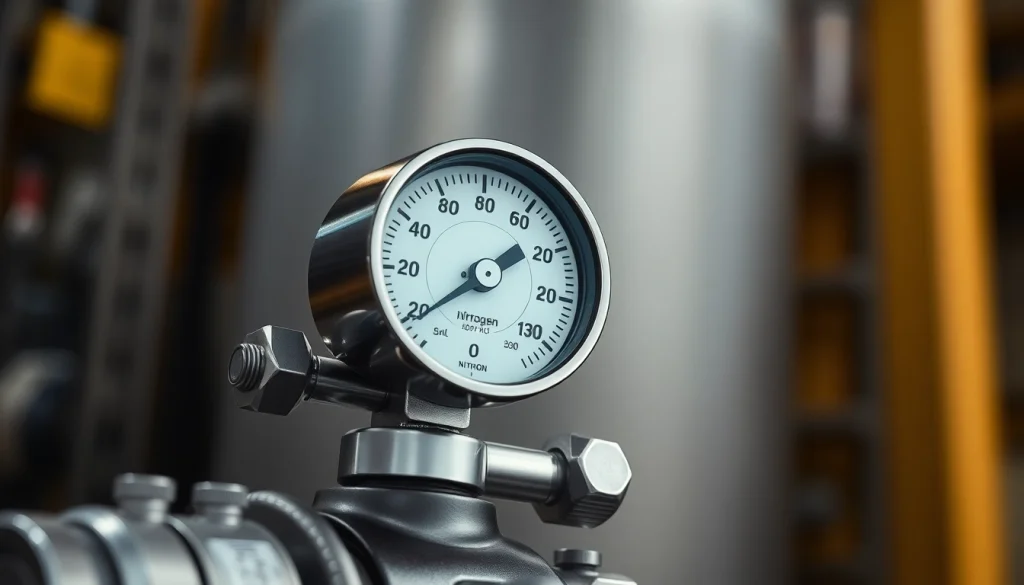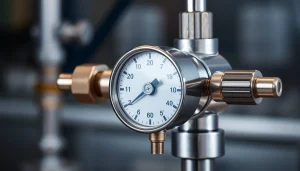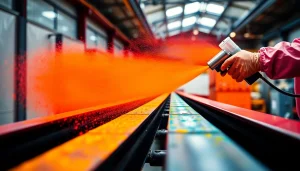Essential Insights on Nitrogen Regulators: Choosing the Right One for Your Needs

Understanding Nitrogen Regulators
Nitrogen regulators are essential devices that play a pivotal role in various industrial and commercial applications. These regulators control and reduce the high pressure of nitrogen gas from cylinders to a manageable level suitable for specific tasks. Familiarizing yourself with the nitrogen regulator can significantly enhance operational efficiency and safety within your workplace. This comprehensive guide will delve into various aspects of nitrogen regulators, including their components, applications, types, selection guidelines, installation, maintenance tips, and ways to maximize their performance.
What is a Nitrogen Regulator?
A nitrogen regulator is a device that modulates the high-pressure nitrogen gas released from storage cylinders, making it usable for a variety of applications. Its primary function is to control outlet pressure, ensuring that the gas is delivered at a safe and effective pressure level. This not only facilitates precise control in industrial processes but also enhances safety by preventing potential system overloads that could result from excessive pressure.
Key Components of a Nitrogen Regulator
Understanding the key components of a nitrogen regulator is crucial for its selection and maintenance. The following are the major parts:
- Pressure Gauge: Displays the pressure levels in the system, allowing operators to monitor conditions accurately.
- Regulating Valve: Adjusts the flow of nitrogen, ensuring that the output pressure meets the specific needs of the application.
- Diaphragm: A flexible membrane that reacts to changes in pressure, effectively controlling the gas flow.
- Inlet and Outlet Connections: These connections allow the regulator to be securely attached to gas cylinders and the tools or systems using nitrogen.
- Body: The main housing of the regulator, which supports the internal components and withstands high pressure.
Applications of Nitrogen Regulators Across Industries
Nitrogen regulators are employed in a wide range of industries, making them indispensable in various operations. Some common applications include:
- Aerospace: Used for purging and pressure testing of aircraft components to ensure safety and compliance with strict regulations.
- Food and Beverage: Nitrogen is used to preserve freshness in packaging, maintain product quality, and enhance the serving experience for beverages like beer.
- HVAC Systems: Employed in refrigerant charging and pressure testing, helping maintain HVAC systems efficiently.
- Welding and Metal Fabrication: Utilized to provide an inert atmosphere during welding processes, preventing oxidation and ensuring better weld quality.
- Pharmaceuticals: Essential in maintaining sterile environments and operations in drug manufacturing and packaging.
Types of Nitrogen Regulators
When selecting a nitrogen regulator, it’s essential to understand the various types available, as each serves unique functional requirements.
Single vs. Dual Outlet Nitrogen Regulators
Nitrogen regulators are available in single and dual outlet configurations:
- Single Outlet Regulators: These are designed for applications that require a single gas outlet, making them suitable for straightforward operations such as pressure testing and purging.
- Dual Outlet Regulators: These regulators provide two separate outlets, allowing for simultaneous use with multiple systems or tools. This feature is especially beneficial in complex setups where multiple processes are occurring at once.
Fixed vs. Adjustable Pressure Nitrogen Regulators
Nitrogen regulators can also vary in their pressure adjustment capabilities:
- Fixed Pressure Regulators: These deliver a constant pressure output suitable for applications with standard demands where precise adjustments are not necessary.
- Adjustable Pressure Regulators: These allow operators to fine-tune the output pressure, making them ideal for applications that require changes in performance based on varying operational conditions.
Choosing the Right Type for Specific Applications
When selecting a nitrogen regulator, consider the specific requirements of your application:
- Assess the pressure and flow requirements of your system to determine whether a fixed or adjustable regulator is more suitable.
- Evaluate whether a single or dual outlet regulator is necessary based on your operational complexity.
- Consider the compatibility of the regulator with your existing tools and systems to avoid operational disruptions.
How to Select a Nitrogen Regulator
Choosing the right nitrogen regulator can have a significant impact on your operations, leading to enhanced efficiency and safety. Here are some key factors to consider when making your selection:
Factors to Consider When Buying
When purchasing a nitrogen regulator, consider the following:
- Pressure Rating: Ensure the regulator can handle the pressure output required for your specific application. Review the manufacturer’s specifications for maximum inlet and outlet pressures.
- Material and Construction: The materials used in the regulator should be compatible with nitrogen and durable enough to withstand the conditions of your operation.
- Certification and Compliance: Choose regulators that meet applicable safety standards and certifications to comply with industry regulations.
- Brand Reputation: Opt for vendors and brands known for reliability and quality to ensure long-term performance and support.
Understanding PSI Ratings and Their Importance
PSI, or pounds per square inch, is a critical metric when dealing with nitrogen regulators. Understanding this rating is essential for:
- Ensuring that the regulator meets the specific demands of your application without risking damage to equipment.
- Choosing the right regulator that operates effectively within the desired pressure range.
- Avoiding safety hazards associated with using a regulator that cannot handle the pressures required in your process.
Cost Comparisons: Budgeting for Your Nitrogen Regulator
The cost of nitrogen regulators can vary significantly based on their features, type, and brand. Here are some considerations for budgeting:
- Initial Investment: Evaluate the cost of the regulator itself, factoring in the need for any additional components or accessories that might be necessary for your operation.
- Long-Term Savings: Consider the efficiency, durability, and maintenance requirements of the regulator; a higher upfront cost may result in lower lifetime costs if it leads to reduced downtime and repair needs.
- Warranties and Support: Review the manufacturer’s warranty and customer service options, as robust support can come as an indirect cost-saving factor over time.
Installation and Maintenance Tips
Proper installation and maintenance are key to ensuring the longevity and performance of nitrogen regulators. Follow these guidelines for optimal results.
Step-by-Step Guide to Installing Your Nitrogen Regulator
- Preparation: Gather necessary tools and safety equipment, including gloves and goggles.
- Locate the Pressure Regulator: Position your nitrogen regulator near the nitrogen cylinder, ensuring easy access to both the cylinder and equipment connected.
- Connections: Connect the inlet of the regulator to the nitrogen cylinder using the appropriate fitting. Ensure it is secured tightly to prevent leaks.
- Attach the Outlet: Connect the regulator outlet to your nitrogen application or equipment, securing it properly.
- Testing: Slowly open the nitrogen cylinder valve and check the regulator pressure gauge to ensure proper operation. Look for any leaks and address them immediately.
Routine Maintenance: Keeping Your Regulator in Top Shape
To maintain peak performance, perform regular inspections and maintenance:
- Inspect all connections for signs of wear or leaks regularly.
- Clean the regulator periodically, following manufacturer guidelines to remove dust and debris.
- Test the pressure gauge annually for accuracy.
- Replace any worn or faulty components immediately to prevent operational issues.
Troubleshooting Common Issues with Nitrogen Regulators
Even with routine maintenance, issues can arise. Here are common problems and their solutions:
- Pressure Fluctuations: Often caused by a malfunctioning diaphragm; check for debris and replace if necessary.
- Leakage: Inspect connections and seals; tight connections and replacing faulty seals should rectify issues.
- Inaccurate Gauge Reading: If the gauge is not providing accurate readings, it may need recalibration or replacement.
Maximizing the Performance of Your Nitrogen Regulator
To ensure that your nitrogen regulator operates at its best, consider implementing the following best practices:
Best Practices for Effective Usage
Utilize your nitrogen regulator effectively by following these tips:
- Ensure the regulator is always used within its specified pressure range.
- Adopt a consistent inspection routine to identify and correct issues promptly.
- Train operators on proper usage techniques to ensure consistency in handling.
Safety Considerations When Operating Nitrogen Regulators
Safety is paramount when working with nitrogen regulators. Keep these safety considerations in mind:
- Always wear appropriate personal protective equipment when handling nitrogen cylinders and regulators.
- Ensure proper ventilation in work areas where nitrogen is used to reduce the risk of asphyxiation.
- Follow established safety protocols when working with high-pressure systems to prevent injuries.
How Proper Use Enhances Efficiency and Safety
Correct installation, maintenance, and operational practices not only prolong the life of a nitrogen regulator but also improve overall safety and efficiency in operations:
- Properly functioning regulators minimize the risk of equipment failure and costly downtimes.
- Trainings on safe handling and operation practices contribute to a safer working environment and protect personnel.
- Efficiency gains from optimal regulator performance directly translate to cost savings and improved productivity.







